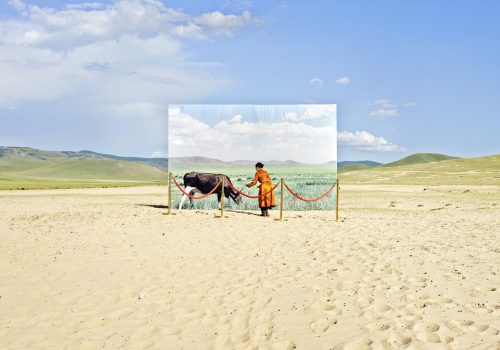Since its beginnings, photography has been the witness, then the lawyer of the consciences, in particular humanistic and ecological. Ansel Adams, already in his time, was an activist engaged in several influential speech groups and lobby groups for Congress and the President, in favor of the values of nature.
Ecological changes, however, are a slow process and are not very visible in the immediate future. Awareness is often a posteriori alarms launched, when we see too late that things are not as they were.
Today more than ever, as California burns and permafrost melts like ice in the sun, it seems necessary to trigger a collective awareness of ecological issues and visualize the scenarios of anticipation.
In any case, this is the challenge that South Korean photographer Daesung Lee embarked on.
Futuristic Archeology tells us about Mongolia. Or rather, desertification in Mongolia.
For centuries, nomadism has been at the center of the country’s culture. Despite urbanization that has intensified in recent years, 35% of the population is still nomadic and therefore depends on the vast pastures, lakes and rivers that cross Mongolia. This way of life is, is however, increasingly threatened by desertification and the advancing Gobi Desert.
The causes of this phenomenon are many, but one of the main reason stems from the changes in the way of life of the nomads. The demand for cashmere from westernized countries, seduced by the material, is increasing steadily. Replacing the traditional sheep with goats, which are big eaters more aggressive for vegetation, and increasing livestock numbers (the number of domestic animals has almost doubled since the 1990s), threatens overgrazing. , which depletes soils, and threatens desertification 80% of this territory is already weakened by global warming (drying lakes and rivers).
If Lee aims to alert, his images are not there to make a judgment. They question, call for reflection and conclusions from each of us. They inform of changes of ecosystems, traditions, customs and lifestyles that depend on a particular environment.
For him, photography is a way to help visualize the trace of the Anthropocene. He sees photography as an accompaniment, an aid to ecological awareness.
His images question us: are we ready to face the changes, to accept the scarcity of water, to see the disappearance of nomadic lifestyles?
In his staging, the photographer also raises the question of inheritance. Through a portrait of a family from the patriarch to the youngest child and from green grass to a stretch of sand, Lee evokes the questions of succession and perpetuation not only of our manners, but of descent. Having children is no longer so trivial when there is nothing left to bequeath – no flocks, no land, no water, no way of life, whether in Mongolia or elsewhere.
Showing pleasant picturesque views of Mongolians in traditional clothes with horses or goats, under a sky almost always blue, his images look like one would look at paintings in a museum, and this is also his will. The images of scenes and landscapes taken from still green areas in the form of large paintings in areas where the sand has finally covered life, such as archaeological remains, are reminiscent of the dioramas of some historical or natural sciences museums.
The photographer blurs the boundaries between present and future, documentary image and fiction. We find ourselves drawn into an anticipatory narrative not so far removed from the real, especially since the protagonists posing for the photographer are all old nomads who had to give up their traditional way of life.
Lee reinvents landscape aesthetics and ecological activism. Here, the banner is a story, a fable, which depicts the strangeness and cruelty of the world in the style of a Grimm’s tale. Fantastic and macabre underlying find themselves face to face. By exposing the beautiful and the ugly, what exists and what is no more, what is and will not be, Lee speaks well of both sides of the same coin and the dangers of a partial vision of things.
Use fiction when photojournalistic imagery does not seem to be enough to talk about the issues: this is the weapon chosen by Daesung Lee to better question, and warn of the risks of an anthropocentric society. The camera becomes a militant banner, questioning its megaphone: Here is the real, here is the soon to be real.
Lee puts us face to the choices that are available to us: act or remain passive, but knowingly.
Daesung Lee – Futuristic Archaeology
05.23.19 – 07.13.19
Galerie &CO119
119 rue Vieille du Temple
75003 Paris
















